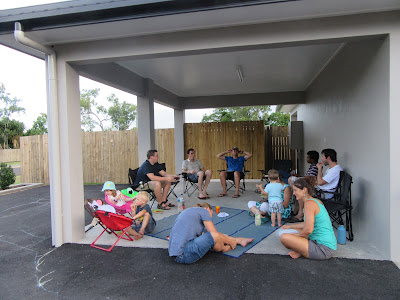On November 24th, we took our first MAF flight as a family. We flew to the remote highland village of Dusin for a week of “bush orientation”. The purpose of the week was to immerse us in the language we have been learning and to allow us to see life from the perspective of one of the communities that MAF serves.
 |
| A week in the mountains |
We left Mt Hagen in rain and cloud which unfortunately meant we couldn’t see much on our 25 minute flight. The Dusin airstrip is the type of airstrip that you see in MAF's exciting promotional materials! It felt a bit like we were flying into one of the videos that we showed so many times while fundraising. The 450m airstrip slopes up from a drop off at the bottom into a mountain at the top – it is one way in and one way out. (Tim didn’t tell me any of this until we were on the ground in Dusin!)
There is no road to Dusin, nor is there a road to walk out to. The only connection that this small community has with the outside world is a scheduled radio call and the airplane that it summons. It is quickly evident how an aircraft is a lifeline to this community. These days there is supposed to be a mobile phone tower serving the area, but the leading theory with the locals is that the rain fills the dish and you need a few dry days before you might get a signal. We met a couple of people who were heading for the three hour hike up the mountain to see if they could call a friend in town.
Watch the Twin Otter take off from Dusin
 |
| Elementary students (grades 1-3). The primary school (4-8) is on the other side of the valley at least an hours walk away. |
Flying into Dusin is like stepping into a missionary biography. There is a rich history here on the Nazarene mission station and the villagers are happy to tell us the stories of the foreign missionaries who came. These days there is no foreign missionary living in Dusin. We were met by the local pastor and settled into the Nazarene mission house, now used for short stays by missionaries and doctors. Next door is an SIL mission house that used to house the family of the missionary who translated the Bible into the Tok Ples (language of this village). The villagers speak highly of him ("He spoke every Tok in these mountains") as well as of the first Nazarene missionaries who hiked in from another airstrip in the district to plant churches in Dusin and the surrounding communities. These early missionaries also established the airstrip in Dusin.
 |
| Tossing a ball in the evening |
We had the privilege of attending the Sunday worship service. The worship songs were mostly in Tok Pisin (the trade language we have been learning) and a little English. The pastor preached in Tok Pisin with another man translating each thought into the Tok Ples (village language). The village is proud to be a community of faith. They will tell you that everyone goes to church, that there is no smoking or buai (betel nut chewing), no fighting or stealing. You can “live free” they say proudly.
 |
| Men tell Tim stories of the first missionaries |
Throughout the week there were frequently men who would come to “tok stori” (talk story) with Tim on the front porch. There were fewer women around as they left early in the morning to walk down into the valley (a couple thousand feet down, I think) to work in the gardens. Those who came taught us about the history of the mission station, their personal stories, how to plant sweet potato or tie up sugar cane, how to hunt with a bow for wild pig or birds, and so much more!
 |
| Demonstration of how to tie sugar cane |
At the end of the week, the pastor’s family put on a mumu for us – cooking local garden produce in a banana-leaf-lined pit. What an amazing opportunity this week was to learn from the people of Dusin about the life and customs of PNG. Everything we’ve recorded here we learned through conversation in Tok Pisin (so if we are in error on any point please forgive us!).
 |
| Steamed taro, sweet potato, greens, corn, cucumber and some pork. |
Our wantok Remi came to pick us up in a GA8 Airvan (this is the plane that Tim will be flying). We awoke to a full view of the mountains and had our bags packed and ready by 7am. By 8am we were sitting inside of a cloud. We heard the Airvan fly over en route to another village but the thick cloud continued until about 11:30am when Remi was able to find a hole to pop through. As we were loading up the plane, planning to sit at the top of the airstrip and wait for another hole, I turned around and behold the whole vista was visible again! I'm told, "That's Dusin".
 |
| Farewell Dusin |
We were able to see the country from above as we flew back. I'm sure I didn't see a road at all until we popped over the ridge and into Mt Hagen. What a beautiful and challenging country.
Check out more photos from our stay in Dusin on our Facebook page: CLICK HERE














































